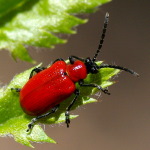Phylum Arthropoda (Arthropods) ➔ Subphylum Hexapoda (Hexapods) ➔ Class Insecta (Insects) ➔ Order Coleoptera (Beetles) ➔ Family Chrysomelidae (Leaf beetles)
Lilioceris lilii (Scopoli, 1763)
Lilienhähnchen Lily Leaf Beetle
Synonyms and other combinations:
Attelabus lilii Scopoli, 1763 | Crioceris merdigera Fabricius, 1775 | Crioceris amurensis Pic, 1916 | Crioceris liliorum Thomson, 1866 | Crioceris melanoceophala Say, 1827 |
Further vernacular names:
Scarlet Lily Beetle, Red Lily BeetleClassification:
Lilioceris lilii belongs to the subfamily Criocerinae, tribe Criocerini.Distribution:
Palearctic; introduced into North America.Habitat:
In light, sunny lime forests and montane tall forb communities; also in gardens, parks and nurseries.Description:
Length 6.0 - 8.0 mm; head, legs and underside black; pronotum and elytra red.Biology:
The Lily Leaf Beetle Lilioceris lilii forms one generation per year in Central Europe.The adults and larvae live on plants of the lily family (Liliaceae). They feed on the leaves of Lilium (lilies), Fritillaria (e. g. chess flower) and Cardiocrinum (giant lilies).
The well flying adults emerge from their winter shelters in April. After mating, the females lay the eggs on the undersides of the leaves of their host plants along the midrib in rows of 2 - 15 pieces each. The oviposition can last until September. A female lays a total of about 200 - 300 eggs. 4 to 10 days after oviposition, the larvae hatch. The larvae pass through 4 larval stages, go into the ground to pupate and pupate in a cocoon. 10 - 20 days later, from the end of June the new generation hatches. After a maturation feeding the beetles retreat into the ground for hibernation.
References, further reading, links:
- Rheinheimer, Joachim, & Hassler, Michael: Die Blattkäfer Baden-Württembergs, 2018, 928 pages, Kleinsteuber Books (Karlsruhe), ISBN 978-3-9818110-2-5
- Arved Lompe: Die Käfer Europas - Ein Bestimmungswerk im Internet
- Agelastica alni
- Altica sp.
- Aphthona nonstriata
- Bromius obscurus
- Bruchus rufimanus
- Bruchus sp.
- Cassida nebulosa
- Cassida rubiginosa
- Cassida sp.
- Cassida stigmatica
- Cassida vibex
- Cassida vibex/bergeali
- Cassida viridis
- Chrysolina fastuosa
- Chrysolina haemoptera
- Chrysolina hyperici
- Chrysolina lucidicollis
- Chrysolina oricalcia
- Chrysolina sp.
- Chrysolina sturmi
- Chrysolina varians
- Chrysomela populi
- Chrysomela tremula
- Chrysomela vigintipunctata
- Clytra laeviuscula
- Clytra quadripunctata
- Coptocephala sp.
- Crepidodera aurata
- Crepidodera aurea
- Crepidodera fulvicornis
- Crioceris duodecimpunctata
- Cryptocephalinae sp.
- Cryptocephalus moraei
- Cryptocephalus nitidus
- Cryptocephalus pusillus
- Cryptocephalus sp.
- Donacia bicolora
- Donacia cinerea
- Donacia marginata
- Donacia versicolorea
- Galeruca tanaceti
- Galerucella s.l.
- Gastrophysa viridula
- Gonioctena decemnotata
- Gonioctena quinquepunctata
- Gonioctena quinquepunctata/intermedia
- Gonioctena sp.
- Gonioctena viminalis
- Lema cyanella
- Leptinotarsa decemlineata
- Lilioceris lilii
- Lochmaea caprea
- Neocrepidodera ferruginea
- Neocrepidodera sp.
- Oulema melanopus/duftschmidi
- Oulema obscura
- Pachybrachis sp.
- Phratora sp.
- Phratora vitellinae
- Phyllobrotica quadrimaculata
- Phyllotreta armoraciae
- Phyllotreta nemorum
- Phyllotreta vittula
- Plagiodera versicolora
- Plagiosterna aenea
- Plateumaris sp.
- Podagrica fuscicornis
- Psylliodes sp.
- Pyrrhalta viburni
- Sphaeroderma sp.
- Xanthogaleruca luteola
